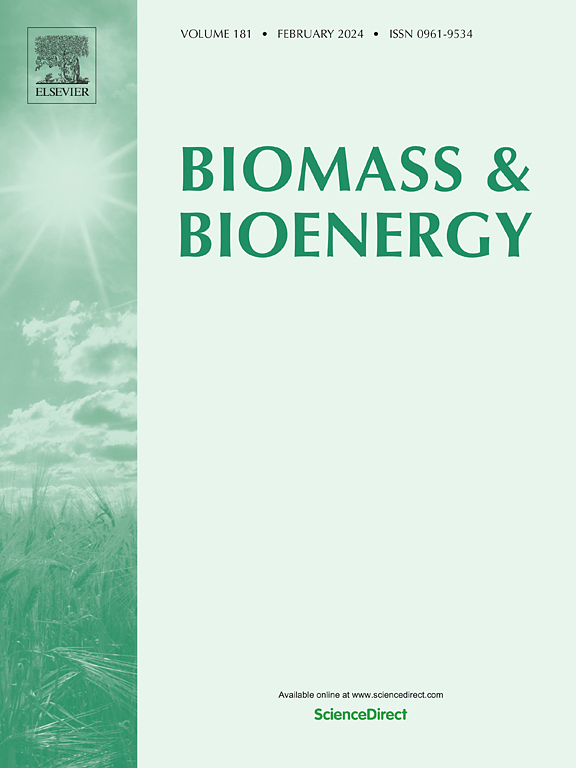新型一步稀酸水热脱木质素法提取油棕叶高纯度纤维素
IF 5.8
2区 生物学
Q1 AGRICULTURAL ENGINEERING
引用次数: 0
摘要
油棕叶(OPF)储量丰富,是一种有前途的可持续资源,但其利用受到纤维素提取过程的限制。本研究介绍了一种经济高效的一步式稀酸辅助水热法,使用稀HNO3 (0.5 M),温度为120°C。在选定的条件下,处理时间为30 min,纤维素提取率为84.2 wt%,木质素含量从21.8%降至9.3 wt%,半纤维素含量从31.6%降至6.4 wt%。处理后的碱性漂洗进一步将纤维素纯度提高到96%,结晶度提高到71.5%。该方法适用于其他生物质,包括油棕空果束(OPEFB),竹子,剑麻和舒罗棕榈纤维,木质素减少高达85%,纤维素收率在78%至85%之间。热稳定性分析表明其分解温度为350℃,XRD分析表明结晶度指数从45%提高到62%。这种简单和可持续的过程,只使用HNO3和水,标志着生物质增值的重要一步,通过减少工业规模的木质纤维素废物利用的化学使用,提供环境效益。本文章由计算机程序翻译,如有差异,请以英文原文为准。
Novel one-step dilute acid-assisted hydrothermal delignification using dilute HNO3 for facile high-purity cellulose extraction from oil palm fronds (OPF)
Oil palm fronds (OPF), available in abundance, represent a promising sustainable resource, yet its utilization is hindered by the demanding process of cellulose extraction. This study introduces a cost-effective, one-step dilute acid-assisted hydrothermal method using dilute HNO3 (0.5 M) at 120 °C. The selected conditions, with a treatment time of 30 min, resulted in cellulose extraction with a purity of 84.2 wt%, reducing lignin content from 21.8 to 9.3 wt% and hemicellulose from 31.6 to 6.4 wt%. A post-treatment alkaline rinse further increased cellulose purity to 96 wt% and crystallinity to 71.5 %. The method's applicability to other biomasses, including oil palm empty fruit bunch (OPEFB), bamboo, sisal, and shuro palm fibre, showed lignin reduction of up to 85 % and cellulose yields between 78 and 85 %. Thermal stability analysis via TGA indicated a decomposition temperature of 350 °C, and XRD analysis showed a crystallinity index increase from 45 to 62 %. This facile and sustainable process, using only HNO3 and water, marks a significant step forward in biomass valorization, providing environmental benefits by minimizing chemical use for industrial-scale lignocellulosic waste utilization.
求助全文
通过发布文献求助,成功后即可免费获取论文全文。
去求助
来源期刊

Biomass & Bioenergy
工程技术-能源与燃料
CiteScore
11.50
自引率
3.30%
发文量
258
审稿时长
60 days
期刊介绍:
Biomass & Bioenergy is an international journal publishing original research papers and short communications, review articles and case studies on biological resources, chemical and biological processes, and biomass products for new renewable sources of energy and materials.
The scope of the journal extends to the environmental, management and economic aspects of biomass and bioenergy.
Key areas covered by the journal:
• Biomass: sources, energy crop production processes, genetic improvements, composition. Please note that research on these biomass subjects must be linked directly to bioenergy generation.
• Biological Residues: residues/rests from agricultural production, forestry and plantations (palm, sugar etc), processing industries, and municipal sources (MSW). Papers on the use of biomass residues through innovative processes/technological novelty and/or consideration of feedstock/system sustainability (or unsustainability) are welcomed. However waste treatment processes and pollution control or mitigation which are only tangentially related to bioenergy are not in the scope of the journal, as they are more suited to publications in the environmental arena. Papers that describe conventional waste streams (ie well described in existing literature) that do not empirically address ''new'' added value from the process are not suitable for submission to the journal.
• Bioenergy Processes: fermentations, thermochemical conversions, liquid and gaseous fuels, and petrochemical substitutes
• Bioenergy Utilization: direct combustion, gasification, electricity production, chemical processes, and by-product remediation
• Biomass and the Environment: carbon cycle, the net energy efficiency of bioenergy systems, assessment of sustainability, and biodiversity issues.
 求助内容:
求助内容: 应助结果提醒方式:
应助结果提醒方式:


